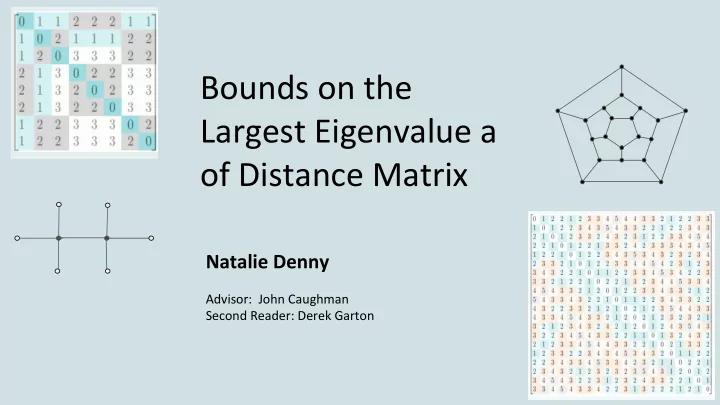

Bounds on the Largest Eigenvalue a of Distance Matrix Natalie Denny Advisor: John Caughman Second Reader: Derek Garton
Overview ● “On the Largest Eigenvalue of the Distance Matrix of a Connected Graph” by Bo Zhou and Nenad Trinajstic ● Application to Chemistry/Chemical Graph Theory ● The Distance Matrix of a Graph ● Bounds on the Largest Eigenvalue ● Nordhaus-Gaddum type result
Application to Chemistry Eigenvalues of distance matrices are used in chemical QSAR (Quantitative Structure-Activity Relationship) and QSPR (Quantitative Structure-Property Relationship) modeling. C 2 H 6 (Ethane) C 20 Fullerene
The Wiener Index ● Named for Harry Wiener (Chemist, Medical Doctor, Pharmaceutical Executive, Psychiatry Researcher) ● The First Topological Index (1947): originally called “The Path Number” ● Was the seed to further molecular descriptors such as using eigenvalues of distance matrices (Bonchev & Trinajstic, 1977)
C 2 H 6 v 1 v 2 v 3 v 4 v 5 v 6 v 7 v 8 v 3 v 4 v 1 0 1 1 2 2 2 1 1 Graph E v 2 1 0 2 1 1 1 2 2 v 3 1 2 0 3 3 3 2 2 v 4 D E = 2 1 3 0 2 2 3 3 v 5 v 8 v 5 v 1 v 2 2 1 3 2 0 2 3 3 v 6 2 1 3 2 2 0 3 3 v 7 1 2 2 3 3 3 0 2 v 8 v 7 v 6 1 2 2 3 3 3 2 0
The Distance Matrix ● Real ● Symmetric ● Non-Negative ● Irreducible D E = Also uniquely determines a graph up to isomorphism!
The Wiener Index D E = ⇒ W(E) = 58
S(G) D E = ⇒ S(E) = 136
The Wiener Index & S(G) limitations The Wiener index & S(G) do not uniquely determine a graph (and hence the underlying structure of the molecule). For example, consider the two graphs below. W(G 1 ) = 8 W(G 2 ) = 8 S(G 1 ) = 12 S(G 2 ) = 12
Bounds on the Largest Eigenvalue D min ≤ λ max ≤ D max 0 < Since distance matrices are real and non-negative, then by the Perron-Frobenius theorem we know that the largest eigenvalue is unique and positive. It is called the Perron root or the Perron-Frobenius eigenvalue. Perron-Frobenius also gives us that λ max is bounded by the minimum and maximum row sum. Let D min and D max be the minimum and maximum row sum of the distance matrix respectively.
Bounds on the Largest Eigenvalue D min ≤ 𝚳 (G) ≤ D max ⇒ 10 ≤ 𝚳 (E) ≤ 16 D E =
Bounds on the Largest Eigenvalue D min ≤ 𝚳 (G) ≤ ≤ n(n-1)/2 D max What about that maximum row sum? . . . 0 1 2 3 n-1 ⇒ D M ≤ n(n-1)/2 D G =
Bounds on the Largest Eigenvalue D min ≤ 𝚳 (G) ≤ n(n-1)/2 D M (E) ≤ 1 + 2 + (8-3)(3) = 18 And we saw that actually, D M (E) = 16.
Bounds on the Largest Eigenvalue D min ≤ 𝚳 (G) ≤ n(n-1)/2 . . . 0 1 2 3 n-1 . . . 1 0 1 2 3 n-2 D G =
Bounds on the Largest Eigenvalue D min ≤ 𝚳 (G) < n(n-1)/2 Using the Rayleigh Quotient, we can deduce that the upper bound is only equal to the largest row sum when the row sums are equivalent. So for n ≥ 3, you have a strict less than n(n-1)/2. . . . 0 1 2 3 n-1 . . . 1 0 1 2 3 n-2 D G =
Bounds on the Largest Eigenvalue 2W(G)/n ≤ D min ≤ 𝚳 (G) < n(n-1)/2 Wiener Index for the win! Previously, 10 ≤ 𝚳 (E) < 16. Now by Lemma 5.3, 14.5 ≤ 𝚳 (E) < 16.
Bounds on the Largest Eigenvalue 2W(G)/n ≤ 𝚳 (G) < n(n-1)/2 Wiener Index This lower bound is always at most 2W(G)/n. But gives a way to express still wins! the lower bound in terms of edges of the graph. Previously, 14.5 ≤ 𝚳 (E) < 16. By Lemma 5.4, 12.25 ≤ 𝚳 (E).
Another Example: C 20 Graph C: D C = C is distance-regular with diameter 5 and valency 3
Another Example: C 20 Distance-Regular gives us Equal Row Sums (D i = 50 for all i) So, W(C) =½ (20)(50) = 500 So by the Perron-Frobenius theorem, 𝚳 (C) = 50.
Bounds on the Largest Eigenvalue of Graphs in Class G The previous two examples also belong to a special class of graphs that have exactly one positive eigenvalue for the distance matrix. We denote this class with G. G includes: ● Infinite families such as: ○ Trees, C n (cycles), Johnson, Hamming, Cocktail Party, Double Half Cubes ● Dodecahedron & Icosahedron ● Petersen graph
Bounds on the Largest Eigenvalue of Graphs in Class G
Bounds on the Largest Eigenvalue of Graphs in Class G 2W(G)/n ≤ 𝚳 (G) < n(n-1)/2 ≤ √[2(n-1)S(G)/n] Previously, 14.5 ≤ 𝚳 (E) < 16. Compare to 𝚳 (C) = 50. By Thm 6.2, 14.5 ≤ 𝚳 (E) < 15.427. Thm 6.2 gives 𝚳 (C) < 54.093.
Nordhaus-Gaddum Type Results Conjecture?
Questions (as long as they aren’t about chemistry :) Thank you to John Caughman and Derek Garton for the support on this incredible journey!
Recommend
More recommend